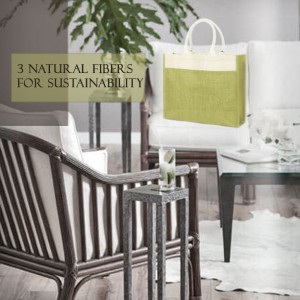3 Natural Fibers for Sustainability
3 Natural Fibers for Sustainability
Natural fibers are great substances that are spun into ropes or thread great in producing fabulous items such as bags, rugs, carpet, carriers, and upholstery. Natural fibers are extracted from the plants and are divided into 3 categories: Fruit fiber, Stem fiber and Leaf fiber.
Fruit Fiber: Fruit fibers are extracted from the fruits of plants and they are light and hairy. Example is cotton, coconut fibers. Cotton is the most important fibers primarily used in the textile industry. Cotton is used in the production of bags, carriers, clothes, outfits etc.
Stem Fibers: Jute, also known as the golden fiber, is one of the most durable natural fibers found on this planet. It’s an annual crop which takes about 120 days to grow and does not need much of pesticides or fertilizers. After Jute plants are harvested, they are bundled and soaked in water for a few days till the fibers are soft and ready to be stripped and dried. It is mostly cultivated in south East Asia in the tropical climate of India and Bangladesh. More than 80% of the world’s jute is grown in these two countries, followed by China. As a natural fiber, just is considered to be second-most globally consumed fiber next to cotton. Jute is excellent for making tote bags, wine bags, and messenger bags as they are strong, durable and ecofriendly.
Flax is a strong fiber also and has a good heat conducting properties. It is hard wearing and durable. Flax is used for the production of linen and canvas, ropes and sacks.
Leaf fibers: Leaf fibers are quite uncommon and rarely cultivate in the field of natural fibre. Among vastly cultivated leaf fibers, sisal is the most popular plant. The plant looks like a humongous pineapple. The leaves and cut and ground. The fibers are scraped by hand or from machine and used for producing ropes, mats, carpet and cement bags.
